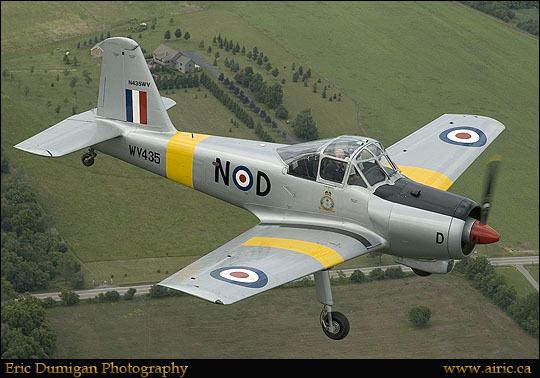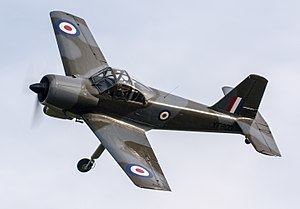Top speed 322 km/h Length 8.69 m Manufacturer Hunting Aircraft | Wingspan 11 m Introduced 1953 First flight February 24, 1950 | |
 | ||
Percival provost
The Percival P.56 Provost was a British basic trainer that was developed for the Royal Air Force in the 1950s as a replacement for the Percival Prentice. It was a low-wing monoplane with a fixed, tailwheel undercarriage and like the Prentice had a side-by-side seating arrangement. The Provost has the distinction of being the last piston-engine basic trainer aircraft to be operated by the RAF.
Contents
- Percival provost
- Percival provost shuttleworth military pageant 2013
- Development
- Design
- Operational history
- Exports
- Variants
- Operators
- Burma
- Ireland
- Malaysia
- New Zealand
- Oman
- United Kingdom
- Specifications T1
- References

The Provost was later adapted to make use of a turbojet engine, producing the BAC Jet Provost. The type was withdrawn in the 1960s, in favour of its jet-powered successor.

Percival provost shuttleworth military pageant 2013
Development

The Provost design is attributed to the Polish-born Aeronautical Engineer, Henry Millicer. Millicer later moved to Australia where he also designed the award-winning Victa Airtourer light aircraft. The Provost was designed to Air Ministry specification T.16/48 for a single-engined basic trainer aircraft to meet Operational Requirement 257 for a Percival Prentice replacement. The specification was issued on 11 September 1948 and the ministry received over 30 proposals. Two designs were chosen for prototype construction, the Handley Page H.P.R. 2 and the Percival P.56. Percival was given a contract dated 13 January 1950 to build two Cheetah-powered prototypes. The company also built a third prototype with an Alvis Leonides Mk 25 engine.

The Armstrong Siddeley Cheetah-powered prototype serial number WE522 first flew on 24 February 1950. After evaluation against the H.P.R. 2 at Boscombe Down, the Leonides-powered P.56 was selected for production as the Provost T.1, with an initial order for 200 aircraft being placed on 29 May 1951. In 1961, production of the type ended with a total of 461 aircraft having been completed. The Percival Provost eventually formed the basis for the Jet Provost trainer which replaced it in RAF service.
Design

The Provost was an all-metal, single-engined, two-seat monoplane; it had fixed conventional landing gear with a fully castoring tailwheel. Production aircraft were powered by a single 550 hp (410 kW) Alvis Leonides 25 radial piston engine. The Provost was twice as powerful as the preceding Percival Prentice. The Provost had a roll rate and handling similar to the best fighters upon entering service, it was also known for its rapid rate of climb and generous power provision from its engine. The type was designed to be easy to maintain; various components were intentionally interchangeable where possible and there was a generous provision of access hatches in the fuselage.
The Provost was developed to provide training better suited to the increasingly complicated operational aircraft that were then being brought into service. To suit the training mission, the two seats in the cockpit were side-by-side so that the instructor could be alongside the student for close observation and to demonstrate flight procedures; a third seat had been specified for an observer but this was later omitted following little use. The three-piece canopy was designed for good crash-worthiness and to facilitate blind flying training in daylight, via extendible amber screens and blue-tinted goggles to restrict the pupil's forward vision and simulate night conditions; the cockpit was also equipped with various approach aids to enable operations in a greater range of weather conditions and to undertake night training. The complexity of the cockpit was deliberate; contrary to earlier trainer aircraft which were simplified so students would find them easy to fly, the Provost was designed so that beginners were exposed to an advanced environment more akin to the varied tasks of aircraft operations.
Operational history
In 1953, the Provost entered service with the RAF, the first batch of aircraft were delivered to the Central Flying School (CFS) at RAF South Cerney. The CFS carried out intensive flight trials in May and June 1953 prior to instructor training commencing. The Provost was more capable than the Prentice it replaced, which allowed students to move straight on to the De Havilland Vampire after completing training on the Provost. On 1 July 1953, 6 Flying Training School at RAF Ternhill started to re-equip with the Provost. The first pupil training course to use the Provost started in October 1953. No. 22 Flying Training School at RAF Syerston was the next to convert and it was followed by 2 FTS at RAF Cluntoe, Northern Ireland, 3 FTS at RAF Feltwell and then the Royal Air Force College at RAF Cranwell.
From 1956 the Provost was issued to some University Air Squadrons, the first being the Queen's University Air Squadron, Belfast in January 1956. The last RAF production aircraft was delivered in April 1956. The aircraft served with the RAF until the early 1960s, when it was replaced by the Jet Provost. A few Provosts continued in service during the 1960s with the Central Navigation & Control School (later Central Air Traffic Control School) at RAF Shawbury until the last example was retired in 1969. Several retired airframes were renumbered with maintenance serials and used for training of airframe and engine tradesmen. At least five Percival Provost have survived as civilian aircraft.
Exports
The first export order was placed in May 1953 by Southern Rhodesia, for four T.1 aircraft which were designated the T.51. Later, the Royal Rhodesian Air Force followed with an order for twelve armed trainers, designated the T.52, which were delivered in 1955.
In January 1954, the Irish Air Corps ordered four T.51 aircraft and in 1960, a further order for six armed T.53 variants. In 1954, the Burmese Air Force also ordered 12 armed T.53 variants and eventually operated a total of 40 aircraft.
In May 1957, the newly formed Sudan Air Force ordered four T.53 armed variant; two were lost in accidents shortly after delivery, a further three were bought in 1959, followed by five former RAF aircraft.
Former RAF aircraft were delivered to Royal Air Force of Oman as armed T.52 variants. In 1955, the Royal Iraqi Air Force ordered 15 armed Provost T.53s, with the first delivered in May 1955. The final export customer was the Royal Malaysian Air Force, who obtained 24 T.51 trainers between 1961 and 1968.
In 1968, Rhodesia obtained further aircraft using a convoluted route to circumvent an arms embargo.
Variants
Operators
Burma
Ireland
Malaysia
New Zealand
Oman
United Kingdom
Specifications (T.1)
Data from World Encyclopedia of Military Aircraft, Military Aircraft of the World
General characteristics
Performance
Armament
